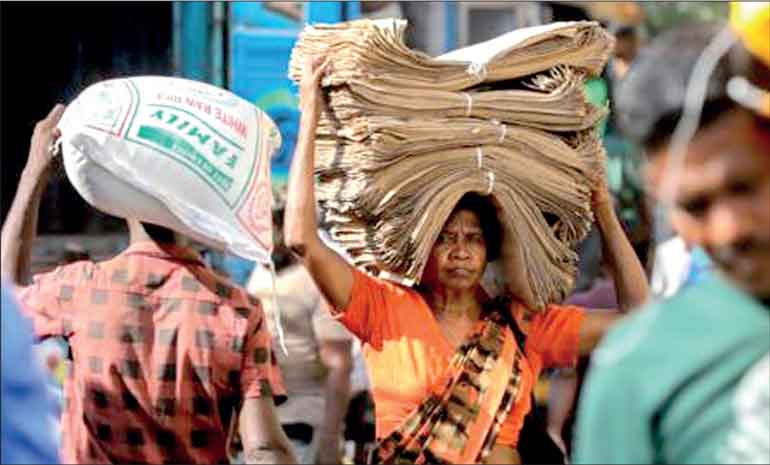Cost of living pandemic and food security
Saturday, 28 December 2024 00:10 – – 20

Although the current cost of living pandemic is the product of viruses originated from outside Sri Lanka, no preventive measures were taken by previous Governments to minimise the infection
There are a few academics and economists who seem to believe that Sri Lanka’s economic revival and future growth should follow the developed world’s techno-industrial trajectory. The former President Ranil Wickremesinghe turned out to be a disciple of this philosophy. Don’t they realise that it is that trajectory which has led humanity to the brink of self-destruction? Let us reject the one size fit all model and cut the cloth to suit our size. This is not a backward-looking strategy but one sustainable in the face of unpredictable and disastrous swings in mega economies
 Cost of living crisis is an economic pandemic spreading to almost every country whether developed or developing. Therefore, the constant barrage of attack on NPP Government over the last few weeks about rising price of coconuts, shortage of rice and salt in the market is not unique to Sri Lanka even though there are certain specific factors such as oligopolistic control and hoarding which make the problem more acute in this country.
Cost of living crisis is an economic pandemic spreading to almost every country whether developed or developing. Therefore, the constant barrage of attack on NPP Government over the last few weeks about rising price of coconuts, shortage of rice and salt in the market is not unique to Sri Lanka even though there are certain specific factors such as oligopolistic control and hoarding which make the problem more acute in this country.
Worldwide of course, Governments and central banks are treating the rise in prices as a sign of inflation. While central banks are fighting to kill this inflation by hiking interest rates, democratic governments that face voter backlash are looking at budgetary solutions to increase the money income of consumers. These are temporary palliatives and not permanent cure to kill the viruses that brought this pandemic in the first place.
Real reason behind crisis
Neither the banks nor the governments are seriously interested in discussing in public the real reason behind this crisis i.e., the supply constraint. There is an absolute shortage in the supply of many consumer items partly because of fall in production and partly because of difficulties in transporting what is produced to consumer outlets. While unpredictable climate changes affect agricultural production the wars in Europe and Middle East disrupt distribution. Shortages therefore raise market prices. Both these viruses originated in the imperial and industrial laboratories of Global North.
CoP29 Climate Conference held in Baku, Azerbaijan this year was a tacit admission of guilt by Global North for its climate damaging techno-industrial economic development trajectory, but it got away from it lightly with a promise of $ 300 billion miserly annual compensation for 10 years to Global South. Tamara Pearson’s “From Gaza to COP29: The 9 Types of Violence Wealthy Countries are Inflicting on the Global South” published in Counterpunch (22 Nov. 2024) summarises the different ways by which Global North inflict violence against developing countries and the current cost of living crisis is the result of that violence.
The latest craze over AI is expected to add to the climate crisis. According to one estimate AI servers to be sold in 2027 will consume between 84 and 134 terawatt-hours annually equivalent to electricity consumption of 18 million people in Netherlands. It is Global North’s limitless avarice for global resources and reckless industrialisation that has led to the current climate crisis which is responsible for global shortages in the supply of humanity’s basic needs.
Imperial drive for domination
The other side is of the coin is the imperial drive for domination which is what is prolonging the wars in Europe and Middle East. Wars divert resources for production of weapons which need to be deadlier than the ones employed already. What is more is that wars make travel unsafe if not impossible. The war in the Middle East has made the Red Sea unsafe for commercial shipping which means economies that depend on this route for external trade are imperilled. Safer but longer routes make exports and imports costly which pushes up the final price in the market and worsen the cost of living.
Small countries like Sri Lanka have no power on their own either to reverse the climate crisis or halt the wars. But individually they could take precautionary measures to minimise the effects from the two. Ecological and environmental catastrophes could be reduced if development projects are subjected to ecological and environmental auditing. This aspect had been neglected for too long under previous governments. For example, the fascination over building highways and expressways under Rajapaksa governments seem to have ignored the impact of bulldozing the hills along those ways which had created havoc during rainy seasons with too many earth-slips and falling trees.
Similarly, deforestation in the name of land reclamation has led not only to frequent flooding and unusually long droughts but also has deprived animals of their livelihood. Elephants are now invading the paddy fields and areas of human settlement. It is in this context that India’s Adani financed wind power project scheduled to be erected in Mannar islands has raised serious concern among local ecologists and environment experts. Their letter to President AKD regarding this matter deserves serious consideration. In general, one would hope that the NPP government does not issue carte blanche to any foreign investment without doing a thorough cost benefit analysis which should include environmental costs.
Environment and cost of living
What does environment got to do with cost of living? Prolonged droughts have forced hundreds of thousands of families in Africa to starve. Their corn crops have been destroyed because of the climate crisis. Food has become a luxury to many of them. The war in Sudan which no news media wants to cover has made the situation intolerable. When compared to Africa, Sri Lanka is a gifted country with salubrious climate and fertile land surrounded by the sea which should create no difficulty to provide food security. It has been a history of systematic economic mismanagement and lopsided prioritisation of peoples’ needs that has created shortages in the supply of victuals and therefore high prices for them.
Everyone knows that the 2006 tsunami destroyed the coconut plantations along the coastline. But was there a Government sponsored replantation project soon after the tsunami? Had there been one the country would not be facing a shortage of coconuts now. Similarly, for far too long the rice market had been under the control of a few large millers. Prices of paddy and rice were systematically manipulated by these oligopolists. They became untouchables by law because of their connections inside corrupt governments.
No preventive measures
Thus, although the current cost of living pandemic is the product of viruses originated from outside Sri Lanka, no preventive measures were taken by previous Governments to minimise the infection. President AKD’s resolve to provide food security by increasing resources to the agricultural sector is to be welcomed. The barrage of attacks levelled by the Opposition against him and NPP Government for shortages in rice, salt and coconut is unwarranted, because these problems have a long history. Rising cost of living is indisputable but a permanent solution to the problem should be found not in raising money income but in increasing local supply and removing supply constraints. The forthcoming Budget and the ones to be prepared thereafter should methodically follow a plan of action and resourcing to tackle the crisis in cost of living.
There are a few academics and economists who seem to believe that Sri Lanka’s economic revival and future growth should follow the developed world’s techno-industrial trajectory. The former President Ranil Wickremesinghe turned out to be a disciple of this philosophy. Don’t they realise that it is that trajectory which has led humanity to the brink of self-destruction? Let us reject the one size fit all model and cut the cloth to suit our size. This is not a backward-looking strategy but one sustainable in the face of unpredictable and disastrous swings in mega economies.
(The writer is attached to Business School, Murdoch University, W. Australia.)






